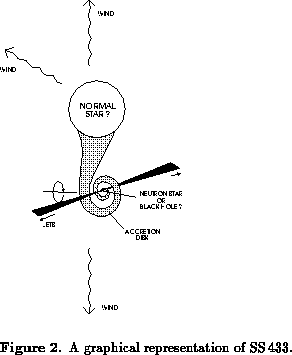SS433 is a binary system. Observations in the V-band show a lightcurve with
a primary and a secondary eclipse. The V magnitude is outside the
eclipses and the orbital period
is almost 13 days. The binary separation
is about 1 AU. The most likely model for SS433 is a system with an early type
star and a compact object which is surrounded by an accretion disk. This
disk provides a symmetry plane which gives a natural environment for producing
near-relativistic jet like structures. Due to the near-relativistic speed
of these beams highly Doppler shifted lines are visible in the spectrum.
It is not exactly clear what the individual contribution from each component
is to the total optical emission. The optical continuum is dominated
by the accretion disk. Line observations show both stationary and
moving lines. The stationary lines show radial velocity variations,
which more or less shows that they are not related to the star itself.
Because of this the nature of the normal star in this system is very
hard to determine.
